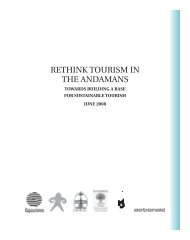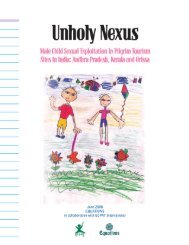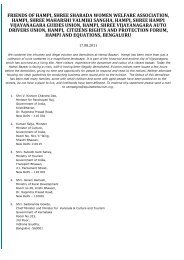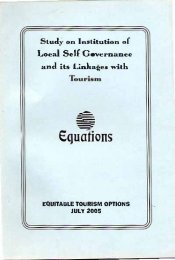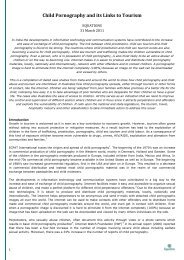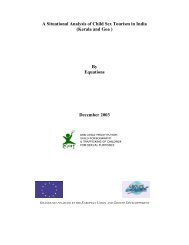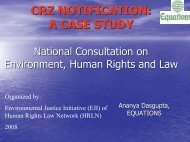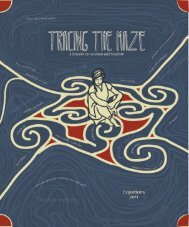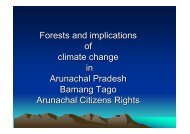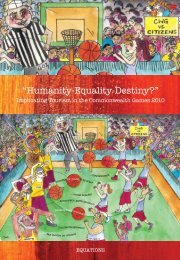Ecotourism as a Market-Based Conservation Scheme-15 Mar 07 ...
Ecotourism as a Market-Based Conservation Scheme-15 Mar 07 ...
Ecotourism as a Market-Based Conservation Scheme-15 Mar 07 ...
You also want an ePaper? Increase the reach of your titles
YUMPU automatically turns print PDFs into web optimized ePapers that Google loves.
little of its purpose of providing guideline and principlesfor implementation viii .Chhattisgarh does not have an ecotourism policy.Information on ecotourism sites is provided on theofficial website ix which states that one of the majorobjectives of the policy is to promote economically,culturally and ecologically sustainable tourism in theState; with ecotourism in the 3 national parks and11 wildlife sanctuaries.The salient features of Madhya Pradesh’s Eco andAdventure Tourism Policy, 2001-02 x includes me<strong>as</strong>uresto involve private participation, b<strong>as</strong>ed on activities,locations and financial considerations. The criterion forsanctioning the project <strong>as</strong> per policy is commercial viabilityof the project and not meeting environmental standardsand zoning regulations. The policy also states that MadhyaPradesh with its richly endowed natural environment,unexploited so far, h<strong>as</strong> immense potential for eco andadventure activities.Uttaranchal does not have a separate ecotourismpolicy but the development of ecotourism h<strong>as</strong> beenincluded in the tourism policy of the state xi ,which w<strong>as</strong> formulated in April 2001. The Policy’s visionis to elevate Uttaranchal into a major touristdestination both nationally and internationally andmake Uttarnachal “synonymous to tourism”.It wishes to develop this sector in an “eco-friendlymanner, with the active participation of the privatesector and the local host communities.” And finally,it wishes to develop tourism <strong>as</strong> a major income earnerfor the state and <strong>as</strong> a source of employment to theextent of being “a pivot of the economic and socialdevelopment in the State.”The state policies focus on ecotourism through privatesector investment. The policies lay a thrust on openingnaturally important and ecologically sensitive are<strong>as</strong> forecotourism. That the lives and livelihoods of communitiesdependent on these natural resources will be impacted,and severely so if ecotourism is unregulated, is hardlyacknowledged in the state level policies.It is the rich natural heritage spread along the forests,mountains, co<strong>as</strong>ts and rivers, all of which are the livingspaces of communities, which constitute the ‘tourismproduct’. Even Protected Are<strong>as</strong>, which have by definitionExample of community conserved area inIndiaRegeneration and protection of 600-700 hectares of forest byJardhargaon village in Uttaranchal state in India. Villagers have alsore-discovered hundreds of varieties of indigenous crops and aresuccessfully growing them organically, and practicing a traditionalsystem of gr<strong>as</strong>sland and water management. In the recent yearthey have also struggled to save not only the forests in their ownvillage but in the surrounding are<strong>as</strong> which are being destroyed bymining or hydro-electric projects [Suryanarayanan, J. and Malhotra,P. (1999)].Source: Pathak, N., Islam, A., Ekaratne, S.U.K., and Hussain, A.“Lessons Learnt in the Establishement and Management of ProtectedAre<strong>as</strong> by Indigenous and Local Communities in South Asia”, IUCN;data retrieved from http://www.iucn.org/themes/ceesp/Publications/TILCEPA/CCA-NPathak.pdf November 2006prohibit commercial activities, are now being seen <strong>as</strong>potential tourism are<strong>as</strong> xii . It is the location of tourism, aresource-intensive activity, in these are<strong>as</strong> that gives riseto a conflict of interests between the needs of localcommunities and conservation with the needs of aconsumer oriented industry which understands nature<strong>as</strong> an economic commodity.The Ministry of Environment & Forests - Governmentof India took steps for setting up protected are<strong>as</strong>: nationalparks and wildlife sanctuaries, and later communityreserves and conservation reserves under the Wild Life(Protection) Act, 1972 and its subsequent amendments.Large populations of indigenous and local communitieswere displaced when these protected are<strong>as</strong> werenotified xiii . And now, the forest departments of manyIndian states, including the study states, planned to developecotourism in many of these protected are<strong>as</strong>. In manyc<strong>as</strong>es, the operations involve the services of indigenous /local communities in the form of guides and workers inlodges etc. While there are inherent problems in themanner in which this form of ecotourism is done, i.e.largely driven by forest departments with little participationof communities in decision making and benefits largelygoing to state exchequers, ecotourism is neverthelessbeing promoted <strong>as</strong> a conservation scheme.Moreover, community-owned tourism initiatives arestill playing a marginal role compared to the othertourism schemes, which are often labelled <strong>as</strong>ecotourism and developed by large, often global,4
tour operators. They consider ecotourism <strong>as</strong> a sourceof sustainable livelihood supplement and not to competefor markets. It is extremely hard for communities tocompete with a market that is fiercely competitive andwhich controlled by financial interests in touristdestinations. Also, negative impacts on local communitiescan be significant <strong>as</strong> operators are very likely to exporttheir adverse environmental impacts, such <strong>as</strong> refuse,w<strong>as</strong>te water and sewage, to parts of the surroundingarea unlikely to be visited by tourists. Most often,governments have overlooked these initiatives and haveextended little support. They have also promoteddifferent versions of tourism <strong>as</strong> ecotourism with no inklingof conservation. Another worrying factor is thatgovernments have used undemocratic means to <strong>as</strong>serttheir roles through policies.Attempts like the World Bank supported Joint ForestManagements (JFM) and India Eco DevelopmentContext for Forest Management in UttarakhandAs the largest custodian of state property, the Forest Departmenth<strong>as</strong> been unable to maintain the forests in good condition or meetpeople’s forest-b<strong>as</strong>ed livelihood needs. Its responsibility forenforcing the Forest <strong>Conservation</strong> and Wild Life Protection Actsh<strong>as</strong> reinforced its image <strong>as</strong> an anti-people agency. Thus, in 1988-89, some of the Chipko activists started yet another, relatively lessknown Ped Kato Andolan (cut trees movement). They argued thatthe Forest <strong>Conservation</strong> Act ‘w<strong>as</strong> being used to hold up b<strong>as</strong>icdevelopment schemes for the hill villages while the builders’ mafiacontinues to flout it brazenly under the guise of promoting tourism’(Rawat, 1998). More recently, resource displacement and loss oflivelihoods caused by expansion of the protected area networkproduced the Cheeno Jhapto Andolan (snatch and grab movement)reflecting the intense feelings of alienation and disempowerment.Women who earned international fame for stopping contractorsfrom felling their forests during Chipko have come to hate theword environment. As one of these women from Reni villagecomplained: ‘They have put this entire (surrounding forest) areaunder the Nanda Devi Biosphere Reserve. I can’t even pick herbsto treat a stomach ache any more’ (Mitra, 1993).Source: Sarin, M. Singh, N. M., Sundar, N. & Bhogal, R. K. (2003).“Devolution <strong>as</strong> a Threat to Democratic Decision-making inForestry? Findings from Three States in India. Working Paper 197.Overse<strong>as</strong> Development Institute, London. Data retrieved fromhttp://www.odi.org.uk/fpeg/publications/papers/wp/197.htmlNovember 2006.Projects have not contributed much to this imp<strong>as</strong>sesince it did not address core issues of community controland access to natural resources. When ecotourismdevelopment permeates these realms of control, thefundamental issues of community rights remainunresolved and the stewardship is shifted to theecotourism industry and its players from the community.4.Financial incentives and theirimpacts on community conservedare<strong>as</strong> xivAt the national level, although the Ministry of Tourism– Government of India h<strong>as</strong> outlined eco-friendlypractices in its <strong>Ecotourism</strong> Policy & Guidelines, 1998,there are very few direct financial incentive schemesin place for supporting ecotourism. The thrustcontinues to be on incentives for infr<strong>as</strong>tructuredevelopment, capital import subsidy, marketing<strong>as</strong>sistance and promotion of ecotourism. Nonetheless,many state tourism policies and plans identify sites thatare to be developed <strong>as</strong> ecotourism destinations withbudgetary support but in most c<strong>as</strong>es, such moneygoes towards building infr<strong>as</strong>tructure and ‘hardware’development rather than any conservation scheme.Where<strong>as</strong> ecotourism is supposed to be lowinfr<strong>as</strong>tructureand therefore low-impact activity, suchhigh focus on infr<strong>as</strong>tructure development goes againstconservation principles. Although the <strong>Ecotourism</strong> Policy& Guidelines prescribe environment-friendly techniqueslike solar, recycling, rain-water harvesting etc, theincentives for incorporating such techniques do not exist.Apart from these government-supported ventures,much of the investment in ecotourism in India h<strong>as</strong>come from the private sector. Taj Hotels PrivateLimited, one of India’s oldest and largest luxury hotelcompanies h<strong>as</strong> made big forays into the ecotourismmarket. Apart from setting up ecological hotels andresorts all across the country, Taj h<strong>as</strong> also beguninvesting in wildlife tourism in <strong>as</strong>sociation with<strong>Conservation</strong> Corporation Africa (CCA) to set upgaming reserves in India. With over 485 sanctuariesand 87 national parks, it is highly lucrative investment xv .Other private investments in ecotourism have beenmostly through local entrepreneurship, with varyingdegrees of scale and investment. These range from5
small-scale initiatives of running activities likehouse-boats and home-stays to investing ineco-resorts and slightly more sophisticated ecotourismproducts. These ventures, being locally b<strong>as</strong>ed andowned also have a significant level of cumulativeimpacts on ecosystems <strong>as</strong> they tend to be clusteredand more in number.An important incentive and support for ecotourismin India h<strong>as</strong> been from UN agencies like the UNEPand UNDP. While the former played a very activerole in the International Year of <strong>Ecotourism</strong> process,the latter h<strong>as</strong> supported different projects withecotourism components through their livelihoods andenvironment programmes. One of the more recentUNDP ventures into tourism h<strong>as</strong> been the UNDP-MoT Endogenous Tourism Project – a “novelecotourism venture” that focuses on promoting ruralarts and crafts through rural tourism at the villagelevel. While the actual financial investment is not clear,development and conservation work through tourismis on the agenda of both UN bodies. However,there is nothing “eco” about this kind of tourism,but MoT promotes it <strong>as</strong> such; where the emph<strong>as</strong>is ison setting up ‘hardware’ (infr<strong>as</strong>tructure), conservationhere takes a back-seat.Indirectly, World Bank supported projects like JointForest Management and India Eco DevelopmentProject have ecotourism <strong>as</strong> an integral market-b<strong>as</strong>edconservation scheme. The World Bank’s Indiareport 16 puts “Ecological and ecotourism values fromcurrent JFM forests could be <strong>as</strong> high <strong>as</strong> $1.7 billion <strong>as</strong>formerly degraded forests mature and begin togenerate important conservation benefits”and “<strong>Ecotourism</strong> and carbon sequestration in forestare<strong>as</strong> have been estimated to incre<strong>as</strong>e national GDPshare from forests from 1.1 to 2.4 percent”.ConclusionsIs ecotourism actually leading to conservation? If so,where are the examples to support ecotourism claims?It is often stated that ecotourism leads to conservationand benefits to local communities. However, what isseen is that ecotourism is not very much differentfrom m<strong>as</strong>s-tourism.<strong>Ecotourism</strong> is targeting are<strong>as</strong> that have been protectedat the cost of communities, where: Communities have been displaced from theirtraditional habitats for the sake of conservationthrough convoluted policies that see no balancebetween conservation and people’s rights. Communities have taken the initiatives forconservation and done a better job of it thangovernment-led and international financialinstitution-supported schemes.But ecotourism is poised to take over these are<strong>as</strong>.When conservation is possible through other means,which h<strong>as</strong> been demonstrated, where is the need tobring in ecotourism when it h<strong>as</strong> failed to achieve itsconservation goals?<strong>Ecotourism</strong> continues to be market-driven withgovernments allowing this to happen with their policiesthat are tailored to meet the needs of privateenterprise. These private players are promotingecotourism in the name of conservation where<strong>as</strong> theirpractices are far from being conservation oriented oreven supporting conservation efforts.<strong>Conservation</strong> could happen if at le<strong>as</strong>t one or more ofthe following criteria are followed:i. If there is regulation being put in on ecotourismdevelopment in terms of infr<strong>as</strong>tructure, touristvolumes or activities;ii. If tourism profits are deployed for conservationpurposes; andiii. If there are genuine ecotourism efforts that wouldnot have allowed m<strong>as</strong>s-tourism to mushroom,thereby controlling development and henceleading to conservation.In reality, these practices do not exist. What exist,however, are incentives that are geared to promoteecotourism and none for conservation.End notesiFriends of the Earth International (2005), “nature:poor people’s wealth - a position paper for the UNWorld Summit and the Review of the MillenniumDevelopment Goals, 14 - 16 September 2005”.6
iiPaquin, <strong>Mar</strong>c & Mayrand, Karel (2005). “MEA-b<strong>as</strong>ed<strong><strong>Mar</strong>ket</strong>s for Ecosystem Services - Draft concept paperprepared for the OECD Workshop on MultilateralEnvironmental Agreements (MEAs) and PrivateInvestment, Helsinki, Finland, 16-17 June 2005”,Unisféra International Centre, data sourced fromhttp:// w w w . u n e p . o r g / d e c / d o c sIIED_ecosystem.pdf November 2006.iiiFor example, in his note on Incentive Me<strong>as</strong>ures tothe 11th meeting of the Subsidiary Body on Scientific,Technical and Technological Advice (SBSTTA) theExecutive Secretary of the Convention on BiologicalDiversity states that “market creation h<strong>as</strong> often provedto be an effective means for the conservation andsustainable use of biodiversity”.iv“How Green is my tourism?”, Express Hoteliers andCaterers, 2004.vThe international guidelines are:1. Guidelines for the development of National Parksand Protected are<strong>as</strong> for Tourism of the UN WTO(World Tourism Organization)2. PATA Code for Environmentally ResponsibleTourism3. Environmental Guidelines for the World Traveland Tourism Council ( WTTC)4. The Himalayan Code of Conduct prepared bythe Himalayan Tourism Advisory Board5. <strong>Ecotourism</strong> Guidelines by The International \<strong>Ecotourism</strong> Society.viThe Policy defines ecotourism <strong>as</strong> drawn up by theUNWTO “tourism that involves traveling to relativelyundisturbed natural are<strong>as</strong> with the specified object ofstudying, admiring and enjoying the scenery and itswild plants and animals <strong>as</strong> well <strong>as</strong> any existing cultural<strong>as</strong>pects ( both of the p<strong>as</strong>t or present) found in theseare<strong>as</strong>”. The policy enlists the key elements ofecotourism <strong>as</strong> being: a natural environment <strong>as</strong> theprime attraction; environment friendly visitors; activitiesthat do not have a serious impact on the ecosystem;and a positive involvement of the local community inmaintaining the ecological balance.viiThe one-page document simply states its vision todevelop the Islands: ‘…<strong>as</strong> a quality destination foreco-tourists through environmentally sustainabledevelopment of infr<strong>as</strong>tructure without disturbing thenatural eco-system with the objective of generatingrevenue, creating more employment opportunitiesand synergies and socio-economic development ofthe island’ (Directorate of Information, Publicity &Tourism 2003. http://www.and.nic.in/Tourism_policy.doc)viiihttp://chhattisgarh.nic.in/tourism/tourism1.htmixhttp://www.mptourism.com/wn/ecopolicy.pdfxhttp://gov.ua.nic.in/uttaranchaltourism/Policy1_vision.htmlxiThe State Tourism Ministers Conference in 1996 that chalkedout guidelines for the development of eco-tourism hadidentified the following resources for tourism development:Biosphere Reserves, Mangroves, Corals and Coral Reefs,Deserts, Mountains and Forests, Flora and Fauna, and Sea,Lakes & Rivers.xii“B<strong>as</strong>ed on a ruling of the Supreme Court of India, the IndianMinistry of Forests and Environment p<strong>as</strong>sed an order to evictall encroachments from forested are<strong>as</strong> by the 30th ofSeptember 2002. While it is not clear how and whether thisorder h<strong>as</strong> really affected the powerful and land hungryencroachers, it h<strong>as</strong> created absolute havoc in the lives of thethousands of forest depended communities. Many of thesepeople being thrown out of their houses and cultivated landsare people who have no other source of revenue and arebeing called encroachers because of their names having notentered the official land records for no fault of theirs”.An e-mail statement issued by Kalpavriksh - Environment andAction Group, India, September 2002.xiiiBusiness Line, “Taj unveils a unique collaborative initiativeto promote wildlife tourism”, August 2004. http://www.thehindubusinessline.com/2005/06/02/stories/2005060200671700.htmxivWorld Bank (2006). “India - Unlocking Opportunities forForest-Dependent People in India”, Agriculture and RuralDevelopment Sector Unit, South Asia Region. Volume I(Report No. 34481 – IN). Data sourced from http://www.worldbank.org.in/WBSITE/EXTERNALC O U N T R I E S / S O U T H A S I A E X TI N D I A E X T N 0 , , c o n t e n t M D K : 2 0 8 7 3 0 3 0~pagePK:141137~piPK:141127~theSitePK:295584,00.html November 2006.Source: Pathak, N., Islam, A., Ekaratne, S.U.K., and Hussain, A. “Lessons Learnt in the Establishement and Management of Protected Are<strong>as</strong>by Indigenous and Local Communities in South Asia”, IUCN; data retrieved from http://www.iucn.org/themes/ceesp/Publications/TILCEPA/CCA-NPathak.pdf November 20067
info@equitabletourism.orgwww.equitabletourism.orgEQUATIONS w<strong>as</strong> founded in 1985 in response toan urge to understand the impacts of tourismdevelopment particularly in the context of liberalisedregimes, economic reforms and the opening up ofthe economy. We envision tourism that is nonexploitative,gender just & sustainable where decisionmaking is democratised and access to and benefits oftourism are equitably distributed.www.equitabletourism.orgGlobal Forest Coalitionwww.wrm.org.uy/gfcThe Global Forest Coalition is an internationalcoalition of Indigenous Peoples Organizations andNGOs that aims to reduce poverty amongst, andavoid impoverishment of, indigenous peoples andother forest-dependent peoples by advocating therights of these peoples <strong>as</strong> a b<strong>as</strong>is for forest policy andaddressing the direct and underlying causes ofdeforestation and forest degradation.www.wrm.org.uy/gfc




